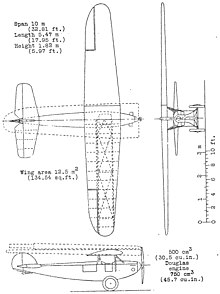Udet U 7
| Udet U 7 hummingbird | |
|---|---|

|
|
| Type: | Sport plane |
| Design country: | |
| Manufacturer: | |
| First flight: |
1924 |
| Number of pieces: |
2 |
The Udet U 7 Kolibri is a light sport aircraft from the 1920s, only two of which were built.
development
The U 7 was the chief engineer at Udet Flugzeugbau GmbH Hans Henry Herrmann for on the Wasserkuppe held Rhon-light aircraft Competition designed by 1924th The concept envisaged a small sports, artificial and touring aircraft for private use, which is why it was kept very small in size and designed so that it could be disarmed by just one person in a few minutes by loosening five bolts . A motorcycle to which the aircraft was attached, tail first, was sufficient for road transport. Two copies were built and registered with the registration numbers D-620 and D-621 .
The competition was a success for the U 7. On August 29, 1924, Ernst Udet managed a continuous flight of 4.39 hours, which was both a victory and a world record for this class. He was also victorious on a flight from the Wasserkuppe to Bad Kissingen , for which he received the price for the lowest fuel consumption (6.12 l). These successes, the company used for an operation performed after marketing campaign, in which the aircraft at a price of 7500 ℛℳ was offered. The orders, however, did not materialize, so that no more copies were built.
In the following year, the aircraft took part in the German round flight 1925 for the BZ price of the air in group A for aircraft up to 29.4 kW (40 hp), but both were eliminated early.
construction
The U 7 is designed as a cantilever high-decker in composite construction with a hull made of plywood . The motor drives a rigid lag screw with a reduction of 1: 3. Behind it is the open pilot's cabin with an entry door on the left and a luggage compartment closed by a flap and only accessible from the outside. The two-part, elliptical wing is connected to the fuselage by struts and consists of an Aludur framework with internal bracing, two box spars and plywood ribs. The tail unit is a fabric-covered wooden construction with a two-part elevator and detachable in one piece. The rigid chassis consists of two disc wheels of relatively large diameter connected to an axle and a grinding spur at the rear.
Technical specifications
| Parameter | Data |
|---|---|
| crew | 1 |
| span | 10.0 m |
| length | 5.5 m |
| height | 1.82 m |
| Wing area | 12.5 m² |
| Wing extension | 8.0 |
| Wing loading | 20.8 kg / m² |
| Power load | 14.5 kg / hp |
| Empty mass | 160 kg |
| Payload | 100 kg |
| Takeoff mass | 260 kg |
| drive | a Douglas (550 cm³) with 18 PS (13 kW) or a Douglas (750 cm³) with 35 PS (26 kW) |
| Fuel supply | 25 l |
| consumption | 6 l / h |
| Top speed | 120 km / h |
| Cruising speed | 100 km / h |
| Summit height | 3200 m |
literature
- Günter Brinkmann, Kyrill von Gersdorff, Werner Schwipps: Sports and travel aircraft. Guidelines for a diverse development (= Die deutsche Luftfahrt . Volume 23 ). Bernard & Graefe, Bonn 1995, ISBN 3-7637-6110-1 , pp. 76 ff .
- K. Grasmann (Hrsg.): Airplane type tables. DMZ 1925-1927 . 1977 (facsimile reprint Deutsche Motor-Zeitschrift No. 5 and 6/1925).
Web links
Individual evidence
- ^ Karl Ries: Research on the German aviation role. Part 1: 1919-1934 . Dieter Hoffmann, Mainz 1977, ISBN 3-87341-022-2 , p. 51 .
- ↑ Bruno Lange: Type manual of German aviation technology. In: German aviation. , Bernard & Graefe, Koblenz 1986, ISBN 3-7637-5284-6 , p. 372.
